Optimized Nitrogen Application Increases Soil Water Extraction by Changing in-Season Maize Root Morphology and Distribution in Rainfed Farmland
Abstract
:1. Introduction
2. Materials and Methods
2.1. Experimental Site
2.2. Experimental Design
2.3. Sampling and Analyses
2.4. Statistical Analyses
3. Results
3.1. Root Length Density and Its Distribution in Different Soil Layers
3.2. Root Weight Density and Its Distribution in Different Soil Layers
3.3. Root Diameter
3.4. Soil Water and Its Relationship with Root Length Density
3.5. Root to Shoot Ratio
3.6. Correlation Analysis
4. Discussion
5. Conclusions
Author Contributions
Funding
Acknowledgments
Conflicts of Interest
References
- Cassman, K.G.; Dobermann, A.; Walters, D.T.; Yang, H. Meeting cereal demand while protecting natural resources and improving environmental quality. Annu. Rev. Env. Resour. 2003, 28, 315–358. [Google Scholar] [CrossRef] [Green Version]
- Liu, W.X.; Ma, G.; Wang, C.Y.; Wang, J.R.; Lu, H.F.; Li, S.S.; Feng, W.; Xie, Y.X.; Ma, D.Y.; Kang, G.Z. Irrigation and nitrogen regimes promote the use of soil water and nitrate nitrogen from deep soil layers by regulating root growth in wheat. Front. Plant Sci. 2018, 9, 32. [Google Scholar] [CrossRef] [PubMed]
- Klocke, N.L.; Watts, D.G.; Schneekloth, J.P.; Davison, D.R.; Todd, R.W.; Parkhurst, A.M. Nitrate leaching in irrigated corn and soybean in a semi-arid climate. Trans. ASAE 1999, 42, 1621–1630. [Google Scholar] [CrossRef]
- Griffis, T.J.; Lee, X.; Baker, J.M.; Russelle, M.P.; Zhang, X.; Venterea, R.; Millet, D.B. Reconciling the differences between top-down and bottom-up estimates of nitrous oxide emission for the U.S. corn belt. Glob. Biogeochem. Cycles 2013, 27, 746–754. [Google Scholar] [CrossRef]
- Tian, X.F.; Li, C.L.; Zhang, M.; Li, T.; Lu, Y.Y.; Liu, L.F. Controlled release urea improved crop yields and mitigated nitrate leaching under cotton-garlic intercropping system in a 4-year field trial. Soil Tillage Res. 2018, 175, 158–167. [Google Scholar] [CrossRef]
- Grant, C.A.; Wu, R.; Selles, F.; Harker, K.N.; Clayton, G.W.; Bittman, S.; Zebarth, B.J.; Lupwayi, N.Z. Crop yield and nitrogen concentration with controlled release urea and split applications of nitrogen as compared to non-coated urea applied at seeding. Field Crop Res. 2012, 127, 170–180. [Google Scholar] [CrossRef]
- Wang, S.J.; Luo, S.S.; Li, X.S.; Yue, S.C.; Shen, Y.F.; Li, S.Q. Effect of split application of nitrogen on nitrous oxide emissions from plastic mulching maize in the semiarid Loess Plateau. Agric. Ecosyst. Environ. 2016, 220, 21–27. [Google Scholar] [CrossRef]
- Wang, S.J.; Luo, S.S.; Yue, S.C.; Shen, Y.F.; Li, S.Q. Fate of 15N fertilizer under different nitrogen split applications to plastic mulched maize in semiarid farmland. Nutr. Cycl. Agroecosyst. 2016, 105, 129–140. [Google Scholar] [CrossRef]
- Azeem, B.; Kushaari, K.Z.; Man, Z.B.; Basit, A.; Thanh, T.H. Review on materials & methods to produce controlled release coated urea fertilizer. J. Control. Release 2014, 181, 11–21. [Google Scholar]
- Trachsel, S.; Kaeppler, S.M.; Brown, K.M.; Lynch, J.P. Maize root growth angles become steeper under low N conditions. Field Crop Res. 2013, 140, 18–31. [Google Scholar] [CrossRef]
- Hunt, D.E.; Bittman, S.; Zhang, H.; Bhandral, R.; Grant, C.A.; Lemke, R. Effect of polymer-coated urea on nitrous oxide emission in zero-till and conventionally tilled silage corn. Can. J. Soil Sci. 2016, 96, 12–22. [Google Scholar] [CrossRef] [Green Version]
- Shaviv, A. Advances in controlled-release fertilizers. Adv. Agron. 2001, 71, 1–49. [Google Scholar]
- He, X.S.; Liao, Z.W.; Huang, P.Z.; Duan, J.X.; Ge, R.S.; Li, H.B.; Geng, Z.C. Characteristics and performance of novel water-absorbent slow release nitrogen fertilizers. Agric. Sci. China 2007, 6, 338–346. [Google Scholar] [CrossRef]
- Noellsch, A.J.; Motavalli, P.P.; Nelson, K.A.; Kitchen, N.R. Corn response to conventional and slow-release nitrogen fertilizers across a Claypan Landscape. Agron. J. 2009, 101, 607–614. [Google Scholar] [CrossRef]
- Payne, K.M.; Hancock, D.W.; Cabrera, M.L.; Lacy, R.C.; Kissel, D.E. Blending Polymer-Coated nitrogen fertilizer improved Bermuda grass forage production. Crop Sci. 2015, 55, 2918–2928. [Google Scholar] [CrossRef]
- Zheng, W.K.; Zhang, M.; Liu, Z.G.; Zhou, H.Y.; Lu, H.; Zhang, W.T.; Yang, Y.C.; Li, C.L.; Chen, B.C. Combining controlled-release urea and normal urea to improve the nitrogen use efficiency and yield under wheat-maize double cropping system. Field Crop Res. 2016, 197, 52–62. [Google Scholar] [CrossRef]
- Guo, J.M.; Xue, J.Q.; Blaylock, A.D.; Cui, Z.L.; Chen, X.P. Film-mulched maize production: Response to controlled-release urea fertilization. J. Agric. Sci. 2017, 155, 1299–1310. [Google Scholar] [CrossRef]
- Fageria, N.K.; Moreira, A. The role of mineral nutrition on root growth of crop plants. Adv. Agron. 2011, 110, 251–331. [Google Scholar]
- Koevoets, I.T.; Henk, V.J.; Elzenga, J.T.M.; Testerink, C. Roots withstanding their environment: Exploiting root system architecture responses to abiotic stress to improve crop tolerance. Front. Plant Sci. 2016, 7, 1335. [Google Scholar] [CrossRef] [Green Version]
- Zhang, X.Y.; Chen, S.Y.; Sun, H.Y.; Pei, D.; Wang, Y.M. Dry matter, harvest index, grain yield and water use efficiency as affected by water supply in winter wheat. Irrig. Sci. 2008, 27, 1–10. [Google Scholar] [CrossRef]
- Chilundo, M.; Joel, A.; Wesstrom, I.; Brito, R.; Messing, I. Response of maize root growth to irrigation and nitrogen management strategies in semi-arid loamy sandy soil. Field Crop Res. 2017, 200, 143–162. [Google Scholar] [CrossRef]
- Shao, H.; Xia, T.T.; Wu, D.L.; Chen, F.J.; Mi, G.H. Root growth and root system architecture of field-grown maize in response to high planting density. Plant Soil 2018, 430, 395–411. [Google Scholar] [CrossRef]
- Dunbabin, V.; Diggle, A.; Rengel, Z. Is there an optimal root architecture for nitratecapture in leaching environments? Plant Cell Environ. 2003, 26, 835–844. [Google Scholar] [CrossRef] [PubMed]
- Xue, X.R.; Mai, W.X.; Zhao, Z.Y.; Zhang, K.; Tian, C.Y. Optimized nitrogen fertilizer application enhances absorption of soil nitrogen and yield of castor with drip irrigation under mulch film. Ind. Crop Prod. 2017, 95, 156–162. [Google Scholar] [CrossRef]
- Chen, X.C.; Zhang, J.; Chen, Y.L.; Li, Q.; Chen, F.J.; Yuan, L.X.; Mi, G.H. Changes in root size and distribution in relation to nitrogen accumulation during maize breeding in China. Plant Soil 2014, 374, 121–130. [Google Scholar] [CrossRef]
- Muñoz-Romero, V.; Benítez-Vega, J.; López-Bellido, R.J.; Fontán, J.M.; López-Bellido, L. Effect of tillage system on the root growth of spring wheat. Plant Soil 2010, 326, 97–107. [Google Scholar] [CrossRef]
- Liu, Y.; Gao, M.S.; Wu, W.; Tanveer, S.K.; Wen, X.X.; Liao, Y.C. The effects of conservation tillage practices on the soil water-holding capacity of a non-irrigated apple orchard in the loess plateau, China. Soil Tillage Res. 2013, 130, 7–12. [Google Scholar] [CrossRef]
- Ritchie, S.W.; Hanway, J.J.; Benson, G.O. How a Corn Plant Develops; Special Report No. 48; Iowa State University, Cooperative Extension Service: Ames, IA, USA, 1992. [Google Scholar]
- Böhm, W. Methods of Studying Root Systems; Springer: Berlin, Germany, 1979. [Google Scholar]
- Wang, Y.H.; Hua, W.L.; Zhang, X.L.; Li, L.X.; Kang, G.Z.; Feng, W.; Zhu, Y.J.; Wang, C.Y.; Guo, T.C. Effects of cultivation patterns on winter wheat root growth parameters and grain yield. Field Crop Res. 2014, 156, 208–218. [Google Scholar] [CrossRef]
- Koide, R.; Peoples, M. On the nature of temporary yield loss in maize following canola. Plant Soil 2012, 360, 259–269. [Google Scholar] [CrossRef]
- Nacry, P.; Bouguyon, E.; Gojon, A. Nitrogen acquisition by roots: Physiological and developmental mechanisms ensuring plant adaptation to a fluctuating resource. Plant Soil 2013, 370, 1–29. [Google Scholar] [CrossRef] [Green Version]
- Wang, Y.; Zhang, X.Y.; Chen, J.; Chen, A.J.; Wang, L.Y.; Guo, X.Y.; Niu, Y.L.; Liu, S.R.; Mi, G.H.; Gao, Q. Reducing basal nitrogen rate to improve maize seedling growth, water and nitrogen use efficiencies under drought stress by optimizing root morphology and distribution. Agric. Water Manag. 2019, 212, 328–337. [Google Scholar] [CrossRef]
- Eissenstat, D.M. Costs and benefits of constructing roots of small diameter. J. Plant Nutr. 1992, 15, 763–782. [Google Scholar] [CrossRef]
- Wiesler, F.; Horst, W.J. Root growth and nitrate utilization of maize cultivars under field conditions. Plant Soil 1994, 163, 267–277. [Google Scholar] [CrossRef]
- Craine, J.M.; Wedin, D.A.; Chapin, F.S.; Reich, P.B. Relationship between the structure of root systems and resource use for 11 North American grassland plants. Plant Ecol. 2003, 165, 85–100. [Google Scholar] [CrossRef]
- Comfort, S.; Malzer, G.; Busch, R. Nitrogen fertilization of spring wheat genotypes: Influence on root growth and soil water depletion. Agron. J. 1998, 80, 114–120. [Google Scholar] [CrossRef]
- Wang, L.; Li, X.G.; Guan, Z.H.; Jia, B.; Turner, N.C.; Li, F.M. The effects of plastic-film mulch on the grain yield and root biomass of maize vary with cultivar in a cold semiarid environment. Field Crop Res. 2018, 216, 89–99. [Google Scholar] [CrossRef]
- Xu, X.; Pang, D.W.; Chen, J.; Luo, Y.L.; Zheng, M.J.; Yin, Y.P.; Li, Y.X.; Li, Y.; Wang, Z.L. Straw return accompany with low nitrogen moderately promoted deep root. Field Crop Res. 2018, 221, 71–80. [Google Scholar] [CrossRef]
- Hu, H.Y.; Ning, T.Y.; Li, Z.J.; Han, H.F.; Zhang, Z.Z.; Qin, S.J.; Zheng, Y.H. Coupling effects of urea types and subsoiling on nitrogen–water use and yield of different varieties of maize in northern China. Field Crop Res. 2013, 142, 85–94. [Google Scholar] [CrossRef]
- Guo, L.W.; Ning, T.Y.; Nie, L.P.; Li, Z.J.; Lal, R. Interaction of deep placed controlled-release urea and water retention agent on nitrogen and water use and maize yield. Eur. J. Agron. 2016, 75, 118–129. [Google Scholar] [CrossRef]
- Mi, G.H.; Chen, F.J.; Wu, Q.P.; Lai, N.W.; Yuan, L.X.; Zhang, F.S. Ideotype root architecture for efficient nitrogen acquisition by maize in intensive cropping systems. Sci. China Life Sci. 2010, 53, 1369–1373. [Google Scholar] [CrossRef]
- Zhang, X.Y.; Zhang, X.Y.; Liu, X.W.; Shao, L.W.; Sun, H.Y.; Chen, S.Y. Incorporating root distribution factor to evaluate soil water status for winter wheat. Agric. Water Manag. 2015, 153, 32–41. [Google Scholar] [CrossRef]
- Wang, L.L.; Palta, J.A.; Chen, W.; Chen, Y.L.; Deng, X.P. Nitrogen fertilization improved water-use efficiency of winter wheat through increasing water use during vegetative rather than grain filling. Agric. Water Manag. 2018, 197, 41–53. [Google Scholar] [CrossRef]
- Ma, S.C.; Li, F.M.; Xu, B.C.; Huang, Z.B. Effect of lowering the root/shoot ratio by pruning roots on water use efficiency and grain yield of winter wheat. Field Crop Res. 2010, 115, 158–164. [Google Scholar] [CrossRef]
- Jackson, R.B.; Caldwell, M.M. The timing and degree of root proliferation in fertile-soil microsites for three cold desert perennials. Oecologia 1989, 81, 149–153. [Google Scholar] [CrossRef] [PubMed]
- Jia, Q.M.; Chen, K.Y.; Chen, Y.Y.; Ali, A.; Manzoor; Sohail, A.; Fahad, S. Mulch covered ridges affect grain yield of maize through regulating root growth and root-bleeding sap under simulated rainfall conditions. Soil Tillage Res. 2018, 175, 101–111. [Google Scholar] [CrossRef]
- Xu, C.L.; Tao, H.B.; Tian, B.J.; Gao, Y.B.; Ren, J.H.; Wang, P. Limited-irrigation improves water use efficiency and soil reservoir capacity through regulating root and canopy growth of winter wheat. Field Crop Res. 2016, 196, 268–275. [Google Scholar] [CrossRef]
- Wang, C.Y.; Liu, W.; Li, Q.; Ma, D.; Lu, H.F.; Feng, W.; Xie, Y.X.; Zhu, Y.J.; Guo, T.C. Effects of different irrigation and nitrogen regimes on root growth and its correlation with aboveground plant parts in high-yielding wheat under field conditions. Field Crop Res. 2014, 165, 138–149. [Google Scholar] [CrossRef]
- Ling, Q.H.; Ling, L. Root function of different depths and their effects on yield in rice. Sci. Agric. Sin. 1984, 17, 3–11, (In Chinese with English Abstract). [Google Scholar]
- York, L.M.; Galindo-Castaneda, T.; Schussler, J.R.; Lynch, J.P. Evolution of US maize (Zea mays L.) root architectural and anatomical phenes over the past 100 years corresponds to increased tolerance of nitrogen stress. J. Exp. Bot. 2015, 66, 2347–2358. [Google Scholar] [CrossRef] [Green Version]
- Lu, P.; Zhang, J.W.; Jin, L.B.; Liu, W.; Dong, S.T.; Liu, P. Effects of nitrogen application stage on grain yield and nitrogen use efficiency of high-yield summer maize. Plant Soil Environ. 2012, 58, 211–216. [Google Scholar] [CrossRef] [Green Version]
- Farmaha, B.S.; Sims, A.L. The influence of PCU and urea fertilizer mixtures on spring wheat protein concentrations and economic returns. Agron. J. 2013, 105, 1328–1334. [Google Scholar] [CrossRef]
- Hyatt, C.R.; Venterea, R.T.; Rosen, C.J.; McNearney, M.; Wilson, M.L.; Dolan, M.S. Polymer-coated urea maintains potato yields and reduces nitrous oxide emissions in a Minnesota loamy sand. Soil Sci. Soc. Am. J. 2010, 74, 419–428. [Google Scholar] [CrossRef]
- Guo, J.M.; Wang, Y.H.; Blaylock, A.D.; Chen, X.P. Mixture of controlled release and normal urea to optimize nitrogen management for high-yielding (>15 Mg ha−1) maize. Field Crop Res. 2017, 204, 23–30. [Google Scholar] [CrossRef]
- Tang, L.; Zhou, J.X.; Zhai, X.F.; Sun, H.R.; Yue, S.C.; Guo, N.; Li, S.Q.; Shen, Y.F. Response of maize productivity and resource use effciency to combined application of controlled-release urea and normal urea under plastic film mulching in semiarid farmland. Agron. J. 2019, 111, 1–13. [Google Scholar] [CrossRef]
- Bai, J.; Li, Y.; Zhang, J.; Xu, F.L.; Bo, Q.F.; Wang, Z.L.; Li, Z.Y.; Li, S.Q.; Shen, Y.F.; Yue, S.C. Straw returning and one-time application of a mixture of controlled release and solid granular urea to reduce carbon footprint of plastic film mulching spring maize. J. Clean. Prod. 2021, 280, 124478. [Google Scholar] [CrossRef]
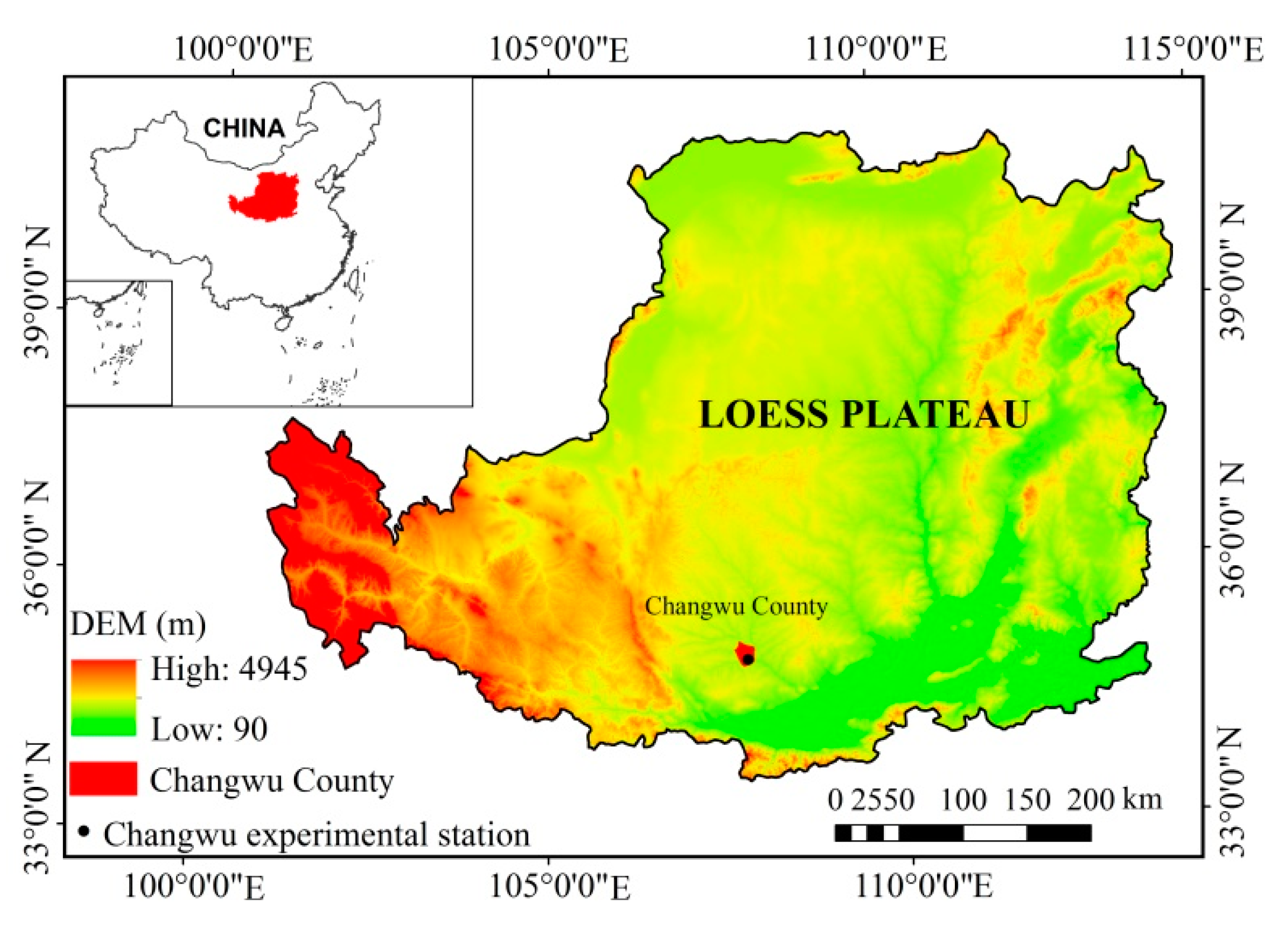
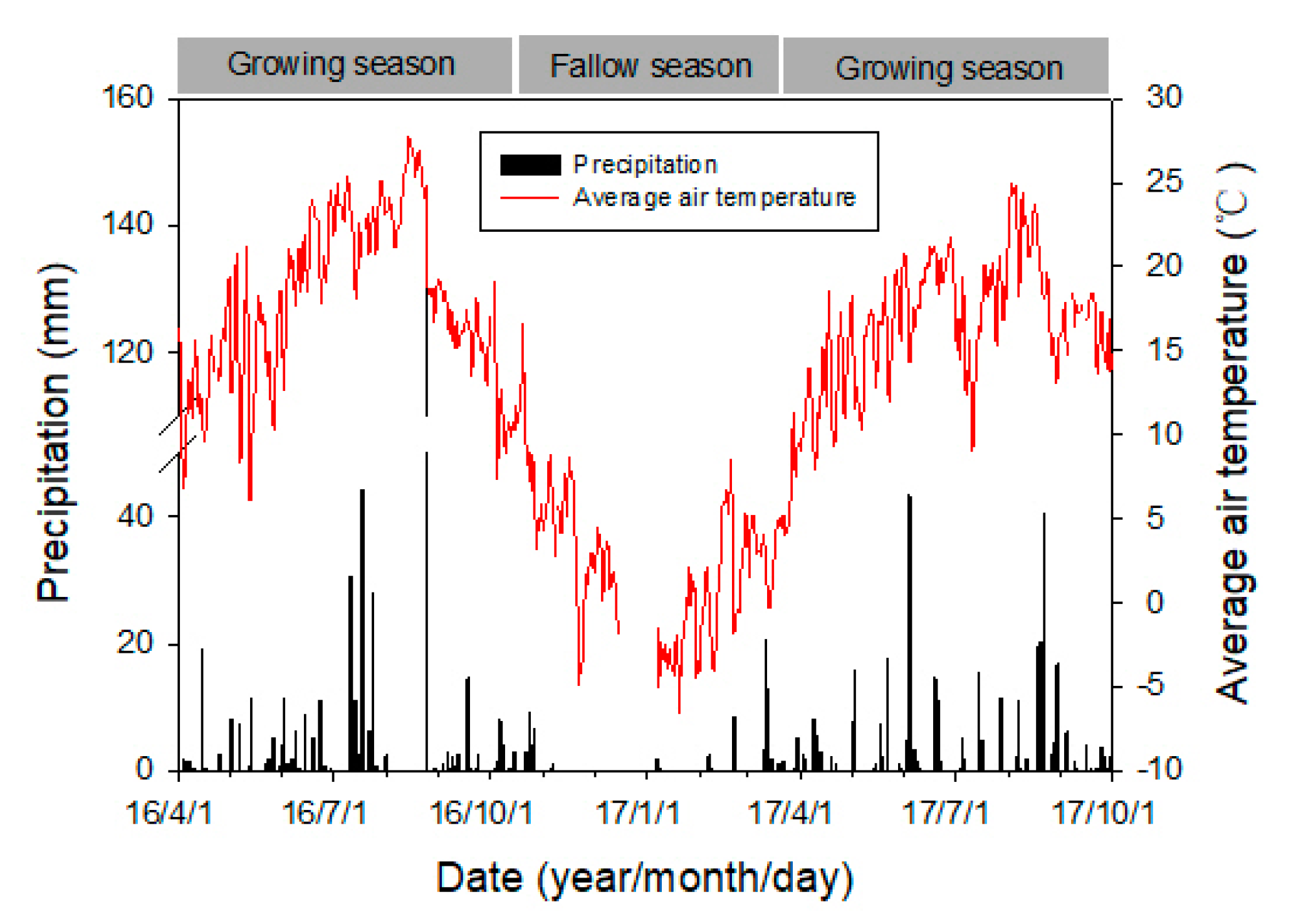
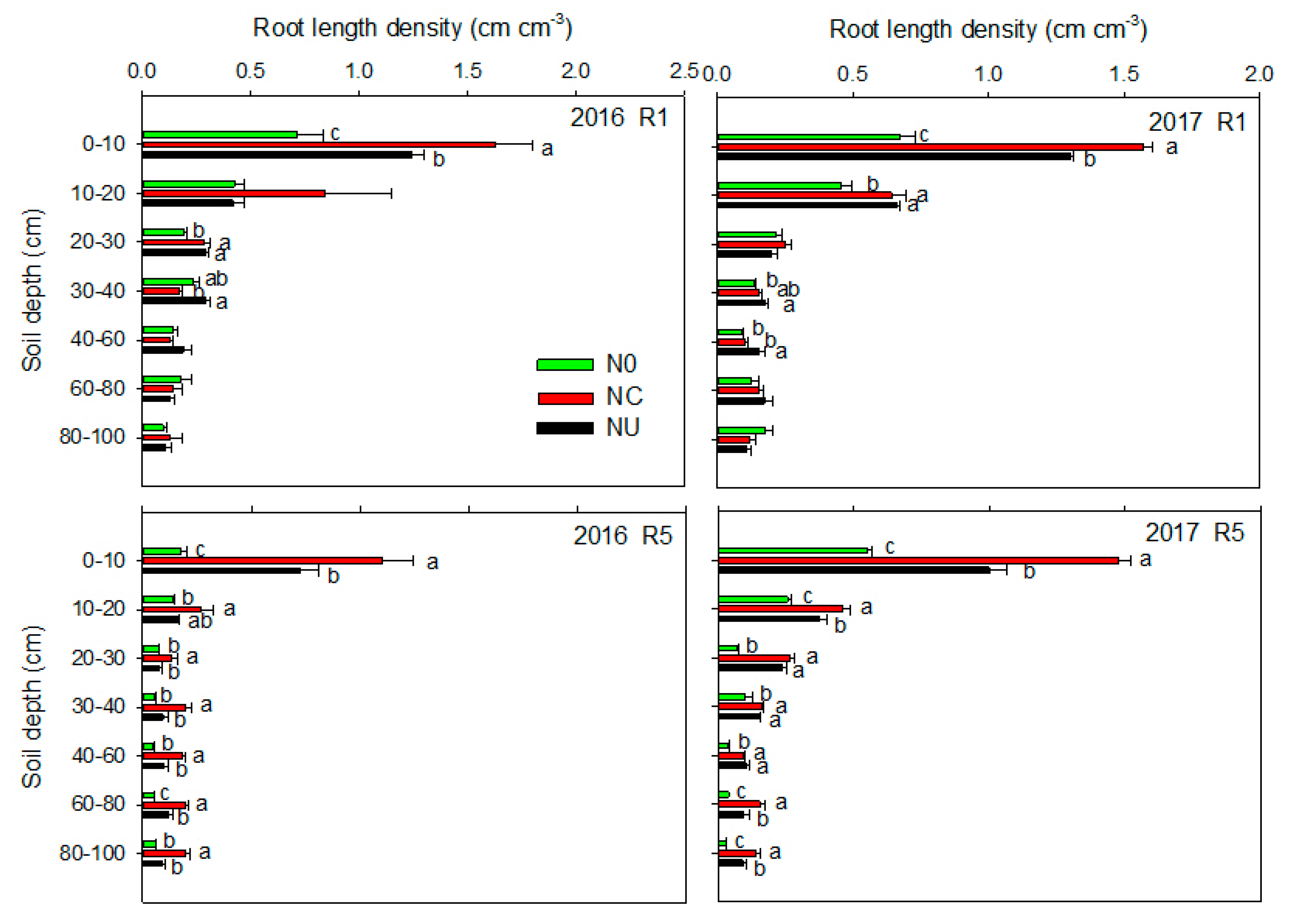



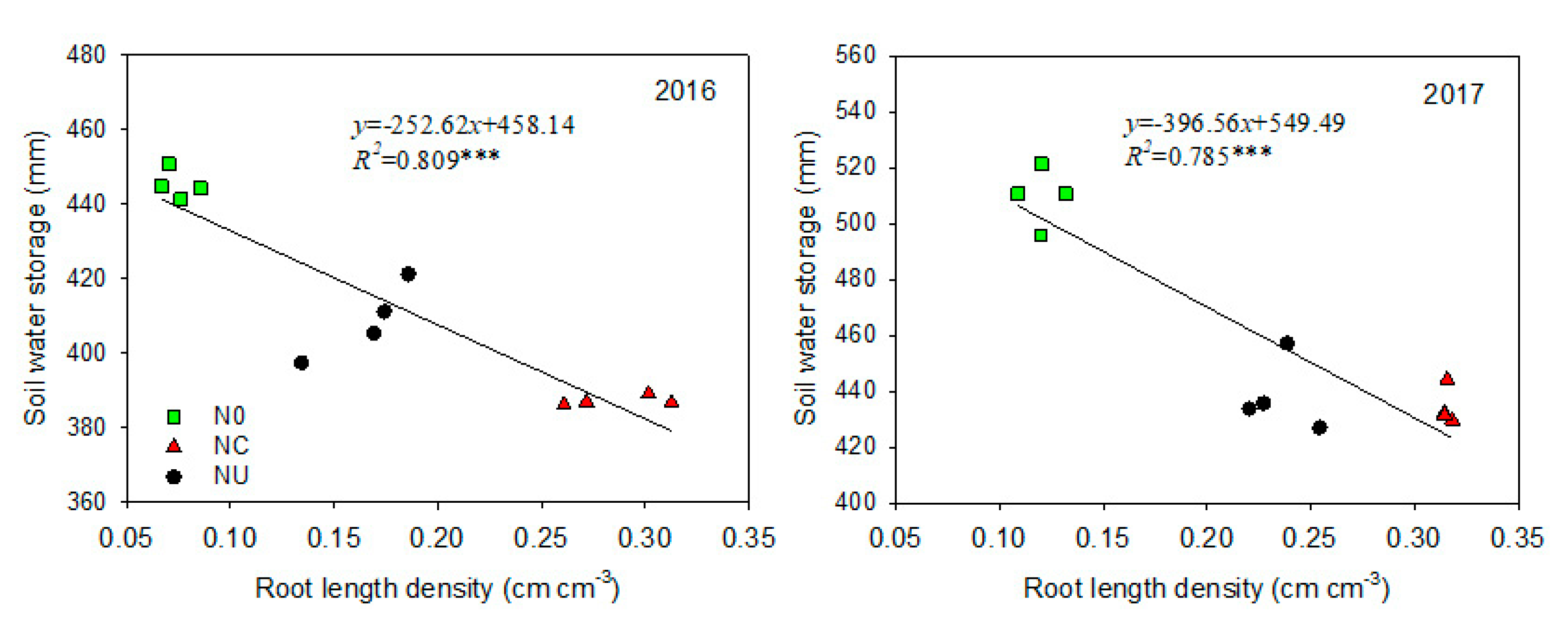
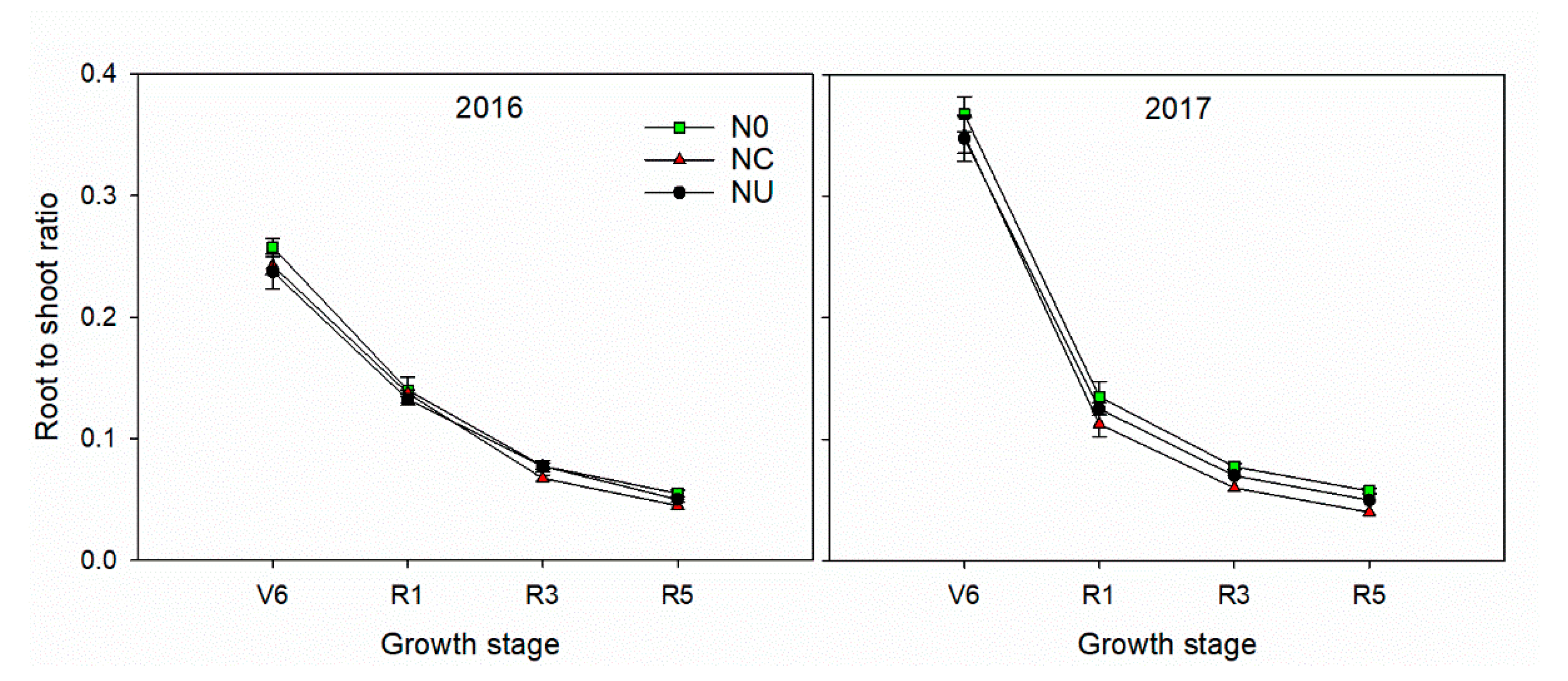
| Year | Treatment | V6 | R1 | R3 | R5 |
|---|---|---|---|---|---|
| 2016 | N0 | 0.19 b | 0.24 b | 0.13 b | 0.08 c |
| NC | 0.20 b | 0.38 a | 0.32 a | 0.29 a | |
| NU | 0.26 a | 0.31 ab | 0.29 a | 0.17 b | |
| 2017 | N0 | 0.21 a | 0.23 b | 0.17 c | 0.12 c |
| NC | 0.18 a | 0.34 a | 0.35 a | 0.32 a | |
| NU | 0.20 a | 0.32 a | 0.28 b | 0.24 b | |
| Source of variation | |||||
| Year (Y) | ns | ns | * | *** | |
| Treatments (T) | ns | ** | *** | *** | |
| Y × T | ns | ns | ns | ns | |
| Year | Treatment | V6 | R1 | R3 | R5 |
|---|---|---|---|---|---|
| 2016 | N0 | 33.3 b | 86.9 c | 57.9 c | 52.3 c |
| NC | 40.8 a | 150.1 a | 143.7 a | 125.0 a | |
| NU | 37.9 ab | 125.0 b | 120.4 b | 108.5 b | |
| 2017 | N0 | 52.6 b | 82.0 b | 61.5 c | 55.5 b |
| NC | 62.7 a | 127.2 a | 125.2 a | 115.7 a | |
| NU | 58.2 ab | 117.8 a | 110.4 b | 105.6 a | |
| Source of variation | |||||
| Year (Y) | *** | ** | *** | ns | |
| Treatments (T) | ** | *** | *** | *** | |
| Y × T | ns | ns | ** | ns | |
| Year | Root Parameters | Growth Stage | 0–20 cm | 20–40 cm | 40–60 cm | 60–80 cm | 80–100 cm |
|---|---|---|---|---|---|---|---|
| 2016 | RLD | V6 | 0.389 | 0.046 | 0.081 | - | - |
| R1 | 0.585 * | 0.494 | 0.135 | −0.275 | 0.191 | ||
| R3 | 0.865 *** | 0.891 *** | 0.646 * | 0.740 ** | 0.718 ** | ||
| R5 | 0.844 ** | 0.572 | 0.700 * | 0.798 ** | 0.669 * | ||
| RWD | V6 | 0.379 | 0.445 | 0.245 | - | - | |
| R1 | 0.895 *** | 0.832 ** | −0.126 | −0.808 ** | 0.135 | ||
| R3 | 0.939 *** | 0.938 *** | 0.948 *** | 0.882 *** | 0.819 ** | ||
| R5 | 0.971 *** | 0.954 *** | 0.643 * | 0.413 | 0.537 | ||
| 2017 | RLD | V6 | −0.148 | 0.236 | −0.471 | - | - |
| R1 | 0.922 *** | 0.336 | 0.337 | 0.308 | −0.610 | ||
| R3 | 0.915 *** | 0.567 | 0.725 ** | 0.797 ** | 0.556 | ||
| R5 | 0.922 *** | 0.928 *** | 0.820 ** | 0.799 ** | 0.880 *** | ||
| RWD | V6 | 0.666 * | 0.207 | −0.335 | - | - | |
| R1 | 0.969 *** | 0.512 | −0.229 | −0.359 | −0.757 ** | ||
| R3 | 0.979 *** | 0.547 | 0.763 ** | 0.687 * | 0.700 * | ||
| R5 | 0.984 *** | 0.929 *** | 0.692 * | 0.663 * | 0.757 ** |
Publisher’s Note: MDPI stays neutral with regard to jurisdictional claims in published maps and institutional affiliations. |
© 2020 by the authors. Licensee MDPI, Basel, Switzerland. This article is an open access article distributed under the terms and conditions of the Creative Commons Attribution (CC BY) license (http://creativecommons.org/licenses/by/4.0/).
Share and Cite
Tang, L.; Sun, H.; Sun, R.; Niu, Y.; Song, J.; Li, S.; Shen, Y. Optimized Nitrogen Application Increases Soil Water Extraction by Changing in-Season Maize Root Morphology and Distribution in Rainfed Farmland. Agronomy 2020, 10, 1606. https://doi.org/10.3390/agronomy10101606
Tang L, Sun H, Sun R, Niu Y, Song J, Li S, Shen Y. Optimized Nitrogen Application Increases Soil Water Extraction by Changing in-Season Maize Root Morphology and Distribution in Rainfed Farmland. Agronomy. 2020; 10(10):1606. https://doi.org/10.3390/agronomy10101606
Chicago/Turabian StyleTang, Liang, Haoran Sun, Ruxiao Sun, Yinan Niu, Jingrong Song, Shiqing Li, and Yufang Shen. 2020. "Optimized Nitrogen Application Increases Soil Water Extraction by Changing in-Season Maize Root Morphology and Distribution in Rainfed Farmland" Agronomy 10, no. 10: 1606. https://doi.org/10.3390/agronomy10101606
APA StyleTang, L., Sun, H., Sun, R., Niu, Y., Song, J., Li, S., & Shen, Y. (2020). Optimized Nitrogen Application Increases Soil Water Extraction by Changing in-Season Maize Root Morphology and Distribution in Rainfed Farmland. Agronomy, 10(10), 1606. https://doi.org/10.3390/agronomy10101606




